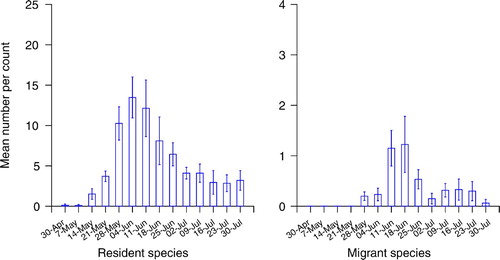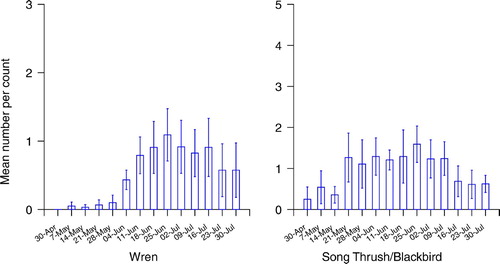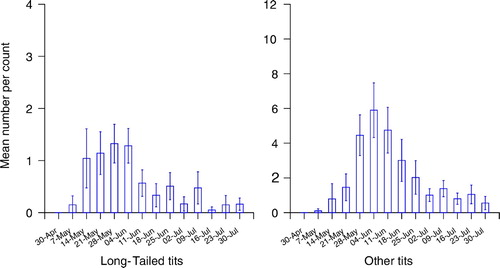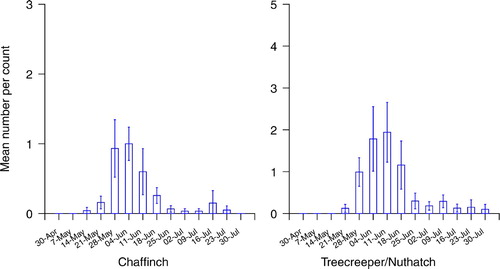Figures & data
Table 1. Characteristics of the larger woodland blocks in which the study sites were situated. All six study sites were composed primarily of lowland mixed broadleaf woodland, NVC W8 or W10 (Rodwell Citation1991), the commonest type of lowland woodland in this region of England (Forestry Commission Citation2003) with other patches of woodland type as indicated. All six study sites were of a similar size (15 ha ± 0.5 ha) and comprised part of the larger blocks as indicated.
Table 2. For 19 bird species recorded from all six study sites, the mean number, by wood, of breeding territories and fledged broods (first broods only), mean number of times each brood was seen, mean duration of encounters with these fledged broods (excluding broods encountered only once) ± 1 se in all cases. Fledging to maturity (Fl – Mat) is taken from Cramp (Citation1985, Citation1988, Citation1992) and Cramp & Perrins (Citation1993, Citation1994). The table is ordered by the naive Territory Occupancy Probability (by fledged broods, TOP). Estimated TOPs take into account detectability of fledged broods using detection probabilities (see Methods and ). The naive and estimated TOPs for fledged broods of a species tend to be more different when the Daily Detection Probabilities (DDP) of fledged broods in are low and vice versa. [GS Woodpecker = Great Spotted Woodpecker.]
Table 3 . Fledged brood Daily Detection Probabilities (DDP) for 19 bird species present in all six study woods (two woods per region). These are the probabilities of detecting a brood in any one survey during the fledging to maturity phase for the particular species (see Methods and ). Differences in probabilities between woods were tested and, when significant, differences within pairs were also tested. Mean DDP ± 1 se using wood-means are also given for each species even if differences between woods were found. This is used in combination with the fledging to maturity period for each species to calculate a mean brood Overall Detection Probability (ODP), the probability of detection at least once when visiting woods four times and two times a week. The table is ordered by ODP. [GS Woodpecker = Great Spotted Woodpecker].
Figure 1. The mean number (± 1 se) of fledged broods encountered per visit to each wood by week; resident species and migrant species. Species occurring in all six woods. See .

Figure 2. The mean number (± 1 se) of fledged broods encountered per visit to each wood by week; Thrushes and Wren.

Figure 3. The mean number (± 1 se) of fledged broods encountered per visit to each wood by week; Long-Tailed Tits and other tit species.

Figure 4. The mean number (± 1 se) of fledged broods encountered per visit to each wood by week; Treecreepers and Nuthatches combined and Chaffinches.
